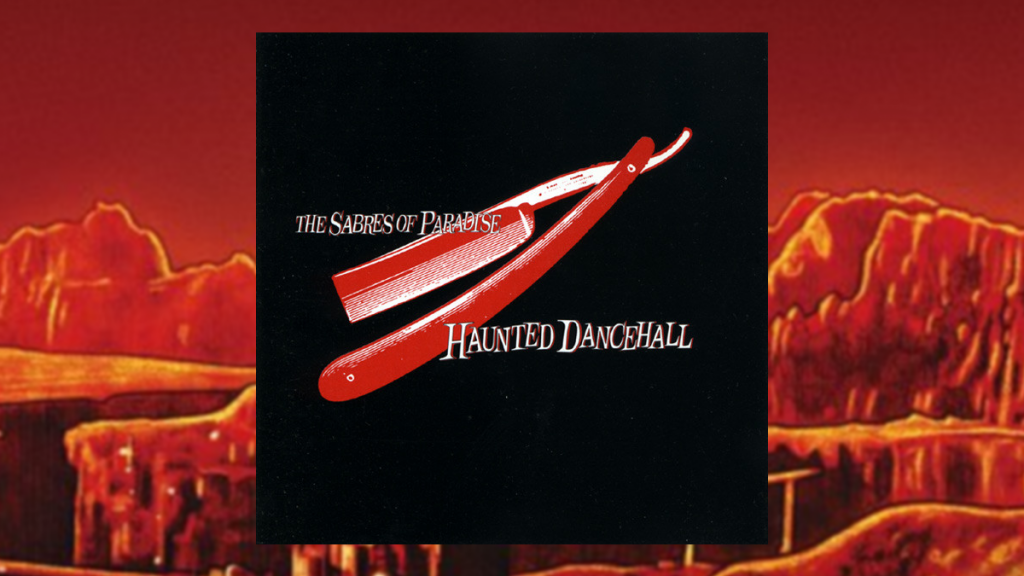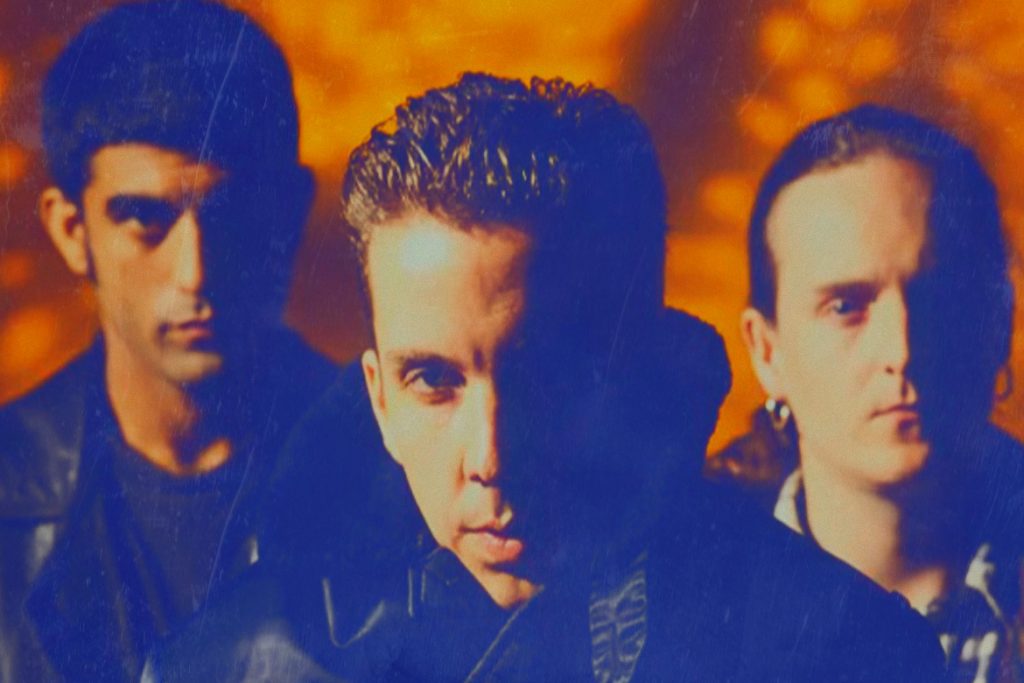Total Recall: The Sabres of Paradise – Haunted Dancehall

Read Time: 6 mins
Originally released in 1994, the Sabres’ follow-up to the previous year’s debut, Sabresonic, reached No. 57 in the UK album charts — significantly lower than its predecessor. However, I would argue it’s the best album they ever released. Formed as a three-piece (Andrew Weatherall, Jagz Kooner, Gary Burns) in 1992, The Sabres of Paradise emerged from the Sabresonic warehouse parties. While ’93’s aptly titled Sabresonic was undoubtedly a brilliant document of rave hedonism and smoked-out after-parties, its follow-up contrasted hugely, sounding like an ice-spine comedown: a dry tongue on a beer can full of cigarette butts, The Ipcress Files, or some weird ’70s British paranormal horror playing on a television set with a broken cathode. And that, dear reader, is precisely my cup of tea.
Haunted Dancehall is the group’s Ghost Town: a brilliant reflection of 1994 in all its weirdness. If 1988 was our second Summer of Love, then 1994 was its first of many breakups. A year when the twelve victims of Fred and Rose West were uncovered, and when we got another glimpse of the British government’s authoritarian bent with the introduction of the Criminal Justice and Public Order Act — a blunt instrument the state and police would later use to crush the free party scene, forcing most dance music back into government-taxable clubs while displacing and criminalising the entire Traveller culture. More than most records, Haunted Dancehall doesn’t just reflect its time in space; it distils it into a fully fledged psychogeographical experience.

The Sabres of Paradise
Haunted Dancehall opens with “Bubble and Slide,” where effervescent rhythms modulate under an ambient collage of long, dreamy pads and — you guessed it — slide guitar, setting the scene for a very London-centric sci-fi spaghetti western of an album. Westworld for the acid generation. It transitions through metallic chops and effects into “Bubble and Slide II,” where robotic mid-tempo breakbeats and 808 bongos create a kind of cybernetic funk that contrasts brilliantly with soft Rhodes samples — reminiscent of the keys in Aquatic Ambience from Nintendo’s “Donkey Kong Country”. There are precursors to early Big Beat here, but darker and more textured.
“The Duke of Earlsfield” fuses classic digidub sensibilities with a sleazy double bass. It’s not far from contemporaries like Red Snapper until about two minutes in, when a weird marimba-like sample takes things in a completely different direction: unhinged, bizarre, eventually descending into industrial bass distortions and phasing drum breaks that give the track a fever-dream quality.
“Flight Path Estate” draws on minimal Kosmische Musik, its echoic percussion creating a cerebral march over looping arpeggios, its perpetual rhythm taking precedence in Nyabinghi fashion. Although a distinctly unfashionable term, Planet D seems to be a literal translation of Trip Hop: dusty, pitched-down Rhodes stabs hang like David Lynch’s red velvet curtains over distorted breaks and intermittent industrial noises. A perfect soundtrack to the cheap squidgy-black Ceredigion couch lockdowns of my youth.
As the smoke clears, the heads-down vibe is replaced with the chest-puffing Balearic dancehall-centred dub of “Wilmot,” its skanking hi-hats, snare rolls, and deep bass carrying you off to some mystic island. The horn sample from calypso legend Wilmoth Houdini’s love letter, Black but Sweet, drifts in. At the risk of sounding old, you won’t find bliss like this today.
“Tow Truck” marries rolling bass, breakbeats, Hammond stabs, and a surf-sleaze guitar line that would make John Barry blush. Delayed timbales punctuate the rhythm as sirens wail. If you listen to it three times, surrounded by candles, Raymond Burr appears.
“Theme” continues the cop-show/spy-movie vibe to its logical conclusion. A wall of wah guitars, heavy breaks, percussion drops, and rising horns create a logical callback to early work on Flowered Up’s seminal Weekender, with vapours of 23 Skidoo’s F.U.G.I. I spent many a teenage afternoon in Borth drumming along to this.
On “Theme 4,” the Sabres discard the cop-show stylings altogether, thrusting the listener into a clinical futurist environment where robotic bleeps drip like digital honey over FM bass drops and ghostly triads. This thread continues in “Return to Planet D,” its alien funk laden with chirps, Solinas, and time-stretched elements, sounding more like the BBC Radiophonic Workshop than anything in clubland.
Back in ’94, I had no frame of reference for the kind of music presented in “The Ballad of Nicky McGuire.” It changed everything for me. As a spotty-faced drummer, I could always get on board with Jungle or Hardcore, but “electro? Drum machines? No mate!” Up to that point, I had no idea machines could have so much soul — those tinny hats and sharp kicks driving soberly, like Crockett through Miami under that soft, whining synth line. The way everything builds on itself incrementally blew my tiny mind and changed my world forever.
“Jacob Street: 7AM” fills the air with a sense of doom. Odd, caged bird sounds create a rhythm over circulating bass and synths, like Primal Scream on a digital comedown — weird and hauntological. But just as almost all hope is lost and the icy comedown takes over, optimism returns with “Chapel Street Market 9AM,” where everything oscillates. Waves of pads float like cumulus as melodies build and phase in and out. My jaw hurts even thinking about it.
Haunted Dancehall closes with its title track, where ill-founded optimism is jarringly replaced with John Carpenter-style horror. Arpeggios climb in quick succession over throbbing distorted bass — an education in music for me.
I was 13 when Haunted Dancehall hit the shelves of my local Woolworths, more indie-kid than raver. I was deep into the Stone Roses, the Mondays, Flowered Up, and some of the floppy-fringed Camden-crawl rakes (I’m looking at you, Suede). Most of my musical education came from the cassettes my art teacher used to play during class, and I doubt I could tell the difference between Ebeneezer Goode and Everybody in the Place. I picked up Haunted Dancehall purely because I liked the cover and wrongly assumed it was some cool, sleazy indie band. A life-changing punt that has served me well for the last 31 years — and one I’ll forever be thankful for.
For more musings, music and middle-aged leftist rants, subscribe to our monthly updates.
